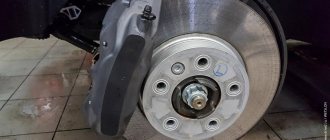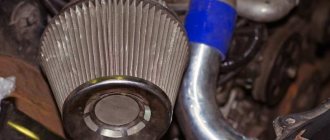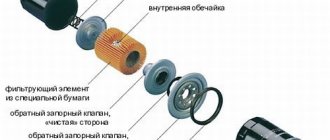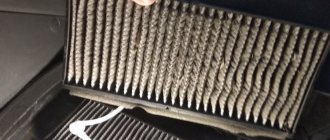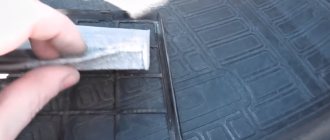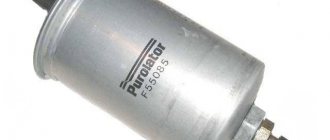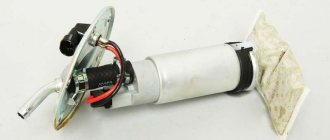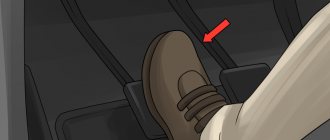During the use of the car, it is imperative to replace the air filters located in the cabin. Usually it is located near the driver’s feet, less often it may be on the right side of the air intake.
Car models are all different and, accordingly, the location of the filter is also different for each, which is why such work is most often entrusted to experts in car service centers. Manufacturers strongly advise that it is necessary to replace cabin filters every 15-20 thousand kilometers.
Thus, it turns out that it should be changed at every technical inspection, but did you pay attention to how clean these filters are after such a mileage. Maybe it’s still worth holding off on replacing it, and you shouldn’t do it so often?
In this article we will analyze in detail what filters are, and also tell you how often they should be changed.
If we consider the issue as a whole, then it is still worth adhering to the manufacturers’ advice - this is necessary, at a minimum, in order to maintain your health in perfect order. But such recommendations are often associated with extracting more money from the car owner. For example, try to study the components market in your city and compare with the prices of original filters. You will simply be shocked, because the prices are incredibly high, and the quality often leaves much to be desired.
I would also like to warn car owners in advance who have decided to replace the filter with their own hands. The fact is that if you start to disassemble the car and get to the filter, you may get the impression that it was hidden so far on purpose.
In some car models, it is quite problematic to change the cabin filter on your own, but you can still do it. Fortunately, most cars allow owners to get to their cabin filters almost painlessly.
Benefits of using a cabin filter
A small and very inexpensive accessory appeared only in the 90s of the last (twentieth) century, but today it is considered an integral part of every self-respecting car and indicates that it has a responsible owner. It protects against:
- Exhaust gases from the vehicle in front;
- Not the cleanest roadside air;
- Poplar fluff and pollen floating in the air and rushing at high speed through the car interior.
A simple device provides good protection against anti-freeze vapors and nitrogen dioxide formed during fuel combustion.
Some filters can even prevent unpleasant odors from appearing in the car, and expensive models also have antibacterial properties.
But all these useful characteristics will only work if the part is replaced in a timely manner.
What is smog? What are its types?
There are two types of smog.
- Classic smog, also called London smog or sour smog. Occurs during the winter season, usually from November to February (depending on weather conditions) and is closely related to the heating season. Found in cities in calm weather and fog. The reason for this is the accumulation of pollutants in the air from coal and oil furnaces. An additional reason for its formation is the combustion of pollutants in furnaces. Pollutants emitted from furnaces include fumes from cars, buses and trucks.
- Photochemical smog appears in large cities, on hot and sunny days, at temperatures above 25 °C. Photochemical smog is caused by reactions of accumulated exhaust gases with strong sunlight.
Replacing the Old Cabin Filter
Additional causes of classic and photochemical smog include:
- Accumulation of vehicular traffic in city centers caused by too little street capacity in relation to needs.
- There are too few bypass roads to allow most transit traffic to exit the city limits.
- Poor spatial planning of cities, which caused blockages in air ducts through which smog could naturally escape.
- Geographical location, such as a city located in a valley surrounded by hills, obstructs the flow of air.
- Drivers removing exhaust system components such as three-way catalytic converters in gasoline-powered vehicles, as well as DPF catalytic converters and particulate filters, resulting in increased emissions of dust and toxic substances into the atmosphere.
What harm does smog bring? In recent years, toxic nitrogen oxides, which are primarily dangerous in the presence of photochemical smog, have been primarily mentioned. It is worth remembering that cars and all transport are responsible for only 5% of the world's nitrogen oxide emissions. 95% is the influence of volcanoes, bacteria or electrical discharges. However, nitrogen oxides accumulate in cities, making them even 100 times higher than in other areas. In addition, smog contains polycyclic aromatic hydrocarbons, sulfur oxides, lead, mercury, cadmium, carbon oxides, soot (called particulate matter), pollen, sand, dust, ash, ozone and carbon dioxide.
Large dirt and leaves on the cabin filter - how to deal with it
Most cities have stations that constantly check air conditions. There are also special standards. According to the Ministry of Environment regulation, the permissible average daily limit for particulate matter emissions is 50 micrograms per cubic meter. Exceeding this dose by six times means you need to limit your exposure to air.
So what do drivers do to protect themselves from smog? Use good quality air filters and replace the cabin filter as often as possible, because this is a direct way to improve the air quality inside the car!
Signs that the filter needs to be replaced
If:
- The smell of dust began to be felt in the cabin;
- An unpleasant odor of mold or dampness has appeared;
- Windows sweat quickly;
- People often feel unwell (dizziness, changes in blood pressure);
- The air conditioner is not working well, which means it's time to change the cabin filter.
Most often this happens when the iron horse runs another 10 thousand kilometers.
Driving also negatively affects the rapid clogging of the filter:
- On rural off-road;
- In city traffic jams.
In the case of daily use of the vehicle in such conditions, it makes sense to change the filter without waiting for the coveted number.
What happens if you don’t change the filter or drive without it for a long time?
Many drivers naively believe that they can do without a cabin filter, and some deliberately remove it in the winter, increasing the air flow to the air conditioner radiator. It is worth agreeing that, yes, heating works more efficiently, but another problem arises that will appear after a certain period of time.
Without a filter, dust, soot and other small debris will safely settle on the cooling holes of the radiators, thereby reducing air flow. Thus, when trying to improve heating, by the end of winter you will have to clean the radiators of the air conditioning system, which are not so easy to remove and in most cases cannot be done without contacting specialists. Driving without a filter element has a particularly detrimental effect on the operation of the air conditioner; the evaporator begins to become intensively covered with frost, which increases the load on the compressor and reduces work productivity.
While saving a little money on a cabin filter, you will need to spend thousands on cleaning the ventilation system and repairing the air conditioner. So be careful.
Consequences of untimely replacement of the cabin filter
The easiest way to change filters is on a new car that is under warranty. In this case, the filter will be forced to be changed during the next technical inspection.
But with the end of preferential maintenance, drivers often forget or do not pay attention to the timely replacement of consumables.
Such a decision can create unpredictable consequences. Lack of oxygen, which will have difficulty passing through the layer of dirt, can lead to:
- Slowing down the driver's reaction speed;
- Increased drowsiness;
- Dispersal of attention;
- Irritability;
- The appearance of a headache.
And this, in the end, can cause an accident, the damage from which will be many times greater than replacing the cabin filter in the simplest auto repair shop.
In addition, a clogged air cleaner can cause:
- Reduced stove efficiency;
- Rapid failure of air ducts;
- Fogging of glass at the slightest difference in temperature;
- Radiator contamination.
All this will one day result in quite expensive repairs.
On which cars does the ventilation system fail more often?
The lowest quality units for filtering the air entering the cabin are installed on budget versions of cars. For this reason, car owners have to pay a lot of money to car repair shops for ventilation processing. And all this happens due to the fault of the manufacturers, who did not work out some elements.
Here are the models you most often encounter difficulties with:
- Daewoo Nexia is a car brand with the worst ventilation system, which is also completely ineffective.
- Lada Priora is a well-known domestic car, and it is a leader in ventilation difficulties. Although the car does not have air conditioning, the filter needs to be changed very often, and car owners also have to deal with a number of other problems.
- Chevrolet Lacetti - this car is also common in Russia, its roots come from Daewoo. That’s why you shouldn’t be surprised at the shortcomings in the ventilation system, but unfortunately, this information doesn’t make things any easier for owners.
- Renault Logan 1 is a car that has a number of significant shortcomings, but this was only in the first generation of cars. When the second modification came out, motorists appreciated it, since all the problems were worked out well and now the system functions correctly.
Sometimes air filtration systems break down not because the designers didn't think through the system correctly, but because of the owners. For example, many motorists try to save money on servicing their car, so they buy cheap Chinese filters. For this reason, the entire ventilation system may fail. Treat your car well and have it serviced by specialized services.
Replacing the cabin filter (step by step)
You can do the dismantling and installation yourself; the most difficult part of this process will be finding the location of the filter. To reduce this time, you can read the car's operating manual or browse specialized websites.
Most often, the replacement part is located under the dashboard of the front passenger seat. You can get to it either through the glove compartment or through the engine compartment. It depends on the model and brand of your iron friend.
If you have doubts about your own skill and dexterity, then it is better to entrust the replacement to specialists: almost always, the cabin filter is located quite deep in the bowels of the car, and not every beginner will be able to get to it the first time.
Element location
To change a used filter, you need to understand where it is located. In most cases, the air purifier is mounted on the inside wall of the glove compartment.
In some cases, it can be found under the dashboard on the driver's side.
In Soviet cars, this component is installed either under the windshield or under the hood. In the latter case, it is placed in a special cassette. To accurately determine the location, you need to ask at the service station, or look at your passport yourself.
Types of cabin filter
All types of filters can be divided into two large groups:
- Regular;
- Coal.
They differ in cost and functionality, so before purchasing you should evaluate the combination of price and quality of each proposed option.
It is worth noting right away that original filters, as well as all “original” spare parts, will cost much more than their analogues. But with timely replacement there will not be much difference between these two components. So you can save a little, especially if the machine is not used every day.
How much will a replacement cost?
Almost every motorist has repeatedly wondered about the cost of cleaning equipment for his iron horse. It all depends on the brand and purpose of the filter element for a particular machine.
Let’s say right away that owners of minibuses, SUVs, and large-sized trucks will have to shell out significantly more money for the simple reason that the filter is initially large. The second nuance is the place of purchase and replacement. Official dealers will have a high price , but you will be confident in the quality of the item and will be able, if something happens, to make a claim due to a poor-quality replacement.
The second question is the originality of the component. Modern Chinese analogues, which cost 2 or even 3 times less than the originals, are practically in no way inferior in quality. The service life in both cases is almost the same. Yes, there is a small risk of running into a “fake”, but it’s up to you to decide.
Regular filters
The simplest dust filter is a regular rectangle tightly filled with synthetic fiber. Such devices are capable of trapping soot, dust, and pollen. Filters with special impregnation will prevent particularly dangerous bacteria from entering the cabin.
An additional advantage of such a cabin filter will be its quite reasonable price.
The disadvantages are the inability to cope with toxic substances and odors of the roadway.
Should I buy a new one or make my own?
Making a new filter is a rather labor-intensive process. You need to buy a filter for a kitchen hood in the store, and then cut a fragment out of it. It should perfectly match the size of the old one. Then this fragment is pasted into the frame from the old one. Sealant or hot melt adhesive is used. The resulting filter can only handle dust.
To make a more effective carbon filter, you will need a regular padding polyester filter and a universal carbon filter. Don't forget about activated carbon. The tablets are placed between two pieces of filter material.
On the Internet you can find many options for making filters with your own hands, but you need to spend a sufficient amount of time on this. And it’s not a fact that you will get a quality product. A ready-made filter is not that expensive; it’s easier to buy it in a store.
Carbon filters
More modern devices have better characteristics. They consist of three independent layers:
- The first provides rough cleaning and traps large debris;
- The second one is busy cleaning the air from small particles;
- The third (charcoal) absorbs unpleasant odors and binds volatile compounds hazardous to health.
With the help of such a filter, sulfur and nitrogen oxides are retained, as well as benzene, phenolic and other components that are unpleasant to health.
Good carbon filters trap up to 95% of all harmful substances that fly in the air over the road.
The disadvantages of such devices are the high price and the thinning of the level of activated carbon ahead of schedule. Moreover, the user will not even know about it.
Replacing the cabin filter is a necessary procedure for the normal functioning of the car. Such consumables are not expensive, replacing them will not require a long wait and a search for a super-sophisticated auto center. But the benefits from simple manipulations will be considerable.
How do you know when it's time to change?
The first sign that it is time to change the cabin filter is a decrease in air flow through the heating system. For example, by setting the maximum ventilation level, there will be less air than it should be. Signs by which you can determine whether it needs replacement:
- An unpleasant odor is a reason that the component needs to be replaced.
- If in the summer the air conditioner barely works in the car, and in the winter the heater blows weakly, then it’s time to change the cleaning element.
- Humidity persists in the cabin and the windows fog up, this is a sign of a component failure. Humidity in the cabin appears as a result of water entering the component, so domestic and Chinese cars are at risk of such a “sore” than foreign cars.
If a car with a climate control system is used for a long time with a clogged component (or without it), then get ready to shell out a tidy sum at the service station. Deterioration of the air system as a result of a breakdown of the cleaning element in 98% of cases provokes freezing of the evaporator radiator. Frozen dirt caught in frost, as it thaws, will contribute to the formation of a favorable environment for microbes and a disgusting odor.
Old filter
Here it is no longer possible to solve the problem by replacing the component alone. The dust and dirt that the cleaning element “missed” has apparently already reached the stove or air conditioner, so you need to dismantle the evaporator and clean it yourself. You can go to a service station, where it will cost more.
Component replacement
If you don’t know how to remove the cabin filter, then you don’t have to go to a car service station. Don't know how to change the cabin filter? This can be done easily without using special tools. Whatever the car, and wherever this component is located, you will need a universal set of tools: wrenches and screwdrivers. Correctly replacing the cabin filter is possible at home, so we suggest that you read the articles on replacing the filter on our website.
Photo instructions for replacing the cabin filter
To the exact address
You can find many products on the market that look good and have an attractive price. Many buyers make their choice based on the appearance of the product and its low price. But there is a huge distance between the appearance and the quality of operation of the cabin filter. Sometimes you just want to wonder: is such a filter even capable of fulfilling its duties?
There is a simple rule that can suggest the right choice. On a high-quality filter, the country of production must be indicated: made in... You can find products that mimic Japanese or German ones, but have nothing in common with them, and only because the country of origin is not indicated. The rule is this: if you can’t find out where the filter was made, don’t buy it without regret!
How much does comprehensive body protection cost?
Such a high-tech filter costs about 800–900 rubles. Expensive? How to say. We breathe every day. If we divide the price of a filter by the number of days in a year—filters must be changed at least once a year—we get clean air for 2.3 rubles per day. And this is the price of health! For just over two rubles, you will rid your body of such harmful substances from roads and streets as the aforementioned nitrogen oxides, ozone, carbon monoxide and sulfur dioxide, as well as carcinogens, soot and even microscopic particles of rubber dust swirling over the asphalt.
Which cabin filter to choose for your car?
Selecting equipment for maintenance is a real problem for the modern motorist. I want to use everything original that is exactly suitable for your vehicle. But such funds often turn out to be prohibitively expensive. And this leads to drivers starting to look for analogues. The situation in the market for analog parts is also difficult; dozens of different product features need to be taken into account. Here are just some recommendations for choosing:
- it is worth choosing products of the middle price class, which are not excessively cheap; the most affordable filter parts most often do not last even 5,000 km;
- give preference to manufacturers with a professional name, such as MANN, Knecht, Bosch, rather than unknown Chinese brands without a guarantee of quality and durability;
- It’s worth buying a filter specifically for your car model, otherwise you won’t be able to install the purchased product into a clear groove in the body, you’ll just throw money down the drain;
- carbon devices work great and purify the air better, but the overpayment is often not worth the money requested by the manufacturer, so this choice is entirely yours;
- When purchasing, look at the quality of the surface finish - there are many fakes on the market in which the top part is easily broken through with a finger when pressed.
The better the quality of the filter element, the cleaner the air will be in your cabin. But most often it’s not worth buying the original. It is better to give preference to German filters with a quality guarantee. Most often, the originals are the same Bosch or Knecht, just with a different name. But it doesn’t make sense to pay 2-3 times more for a name. Therefore, when buying maintenance devices, be careful and do not waste money on something you don’t need at all.
